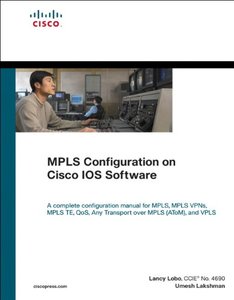買這商品的人也買了...
-
 Microsoft PowerPoint 2003 使用手冊
Microsoft PowerPoint 2003 使用手冊$450$383 -
 傳輸網路與行動通訊
傳輸網路與行動通訊$380$342 -
 Dreamweaver MX 2004 網頁設計風暴
Dreamweaver MX 2004 網頁設計風暴$380$342 -
 Linux 指令詳解辭典
Linux 指令詳解辭典$650$553 -
 UML 精華第三版 : 標準物件模型語言 (UML Distilled, 3/e)
UML 精華第三版 : 標準物件模型語言 (UML Distilled, 3/e)$460$363 -
 $1,782Linux Device Drivers, 3/e (Paperback)
$1,782Linux Device Drivers, 3/e (Paperback) -
 CCNA Cisco Certified Network Associate Study Guide, 5/e (640-801)
CCNA Cisco Certified Network Associate Study Guide, 5/e (640-801)$1,700$1,666 -
 Linux iptables 技術實務─防火牆、頻寬管理、連線管制
Linux iptables 技術實務─防火牆、頻寬管理、連線管制$620$527 -
 Shell Programming 333 個應用範例技巧大全集
Shell Programming 333 個應用範例技巧大全集$560$437 -
 知識管理理論與實務, 2/e
知識管理理論與實務, 2/e$350$315 -
 Database System Concepts, 5/e (IE) (美國版ISBN:0072958863)
Database System Concepts, 5/e (IE) (美國版ISBN:0072958863)$1,150$1,127 -
 深入淺出 Java 程式設計, 2/e (Head First Java, 2/e)
深入淺出 Java 程式設計, 2/e (Head First Java, 2/e)$880$695 -
 Java 認證 SCJP 5.0 猛虎出閘
Java 認證 SCJP 5.0 猛虎出閘$650$514 -
 CSS 功能索引式參考手冊
CSS 功能索引式參考手冊$390$332 -
 網管員必讀網路故障排除手冊 Network Administration
網管員必讀網路故障排除手冊 Network Administration$590$460 -
 SQL Server 2005 資料採礦聖經
SQL Server 2005 資料採礦聖經$650$553 -
 Microsoft Operations Manager 2005 IT 智慧整合管理實務
Microsoft Operations Manager 2005 IT 智慧整合管理實務$520$411 -
 鳥哥的 Linux 私房菜基礎學習篇, 2/e
鳥哥的 Linux 私房菜基礎學習篇, 2/e$780$663 -
 Linux 驅動程式, 3/e (Linux Device Drivers, 3/e)
Linux 驅動程式, 3/e (Linux Device Drivers, 3/e)$980$774 -
 ActionScript 3.0 精緻範例辭典
ActionScript 3.0 精緻範例辭典$550$468 -
 最新 JSP 與 Servlet 600 個活用範例大全, 2/e
最新 JSP 與 Servlet 600 個活用範例大全, 2/e$620$484 -
 最新 Java 2 程式語言, 2/e
最新 Java 2 程式語言, 2/e$650$553 -
 現代嵌入式系統開發專案實務-菜鳥成長日誌與專案經理的私房菜
現代嵌入式系統開發專案實務-菜鳥成長日誌與專案經理的私房菜$600$480 -
 程式之美-微軟技術面試心得
程式之美-微軟技術面試心得$490$387 -
 ASP.NET 3.5 應用系統專題實作
ASP.NET 3.5 應用系統專題實作$590$460
相關主題
商品描述
Description
Next Generation SDH/SONET provides a detailed description of the enablers of efficient data transport over any synchronous network. These include virtual concatenation (VCAT), the operation to provide more granularity, and the link capacity adjustment scheme (LCAS), an extension of VCAT that provides more flexibility. Equally, generic framing procedure (GFP), the methodology that efficiently transports asynchronous, or variable bit-rate data signals over a synchronous or constant bit-rate, is explored in detail.
● Describes new extensions to SDH/SONET standards to provide more granularity and flexibility in their structures, enabling the efficient transport of data-related signals such as Ethernet and FICON
● Presents comprehensive sections on the implementation of multi-service transport platforms (MSTP) enabled by VCAT, LCAS and GFP
● Provides valuable advice on how to exploit existing networks to create or extend LANs towards metro (MAN) or wide (WAN) area networks and also to support storage area (SAN) networks
This volume will appeal to manufacturers, engineers and all those involved in developing and deploying SDH, SONET and OTN technology. It will also be an invaluable resource for postgraduate students on network communications courses.
商品描述(中文翻譯)
**描述**
自二十世紀初以來,電信已經從傳統的語音傳輸轉向數據傳輸,儘管數位語音仍然是重要的貢獻者。為了啟用額外的數據相關傳輸,必須進行一場革命,而不是僅僅演變現有的傳輸標準。
《下一代 SDH/SONET》詳細描述了在任何同步網絡上高效數據傳輸的促成因素。這些因素包括虛擬串接(VCAT),這是一種提供更高粒度的操作,以及鏈路容量調整方案(LCAS),這是 VCAT 的擴展,提供了更多的靈活性。同樣,通用幀程序(GFP)也被詳細探討,這是一種高效地在同步或恆定比特率上傳輸異步或可變比特率數據信號的方法。
● 描述了 SDH/SONET 標準的新擴展,以提供更高的粒度和靈活性,使得以太網和 FICON 等數據相關信號的高效傳輸成為可能。
● 提供了有關由 VCAT、LCAS 和 GFP 支持的多服務傳輸平台(MSTP)實施的全面部分。
● 提供了有關如何利用現有網絡來創建或擴展局域網(LAN)到城域網(MAN)或廣域網(WAN),以及支持存儲區域網(SAN)的寶貴建議。
本書將吸引製造商、工程師以及所有參與開發和部署 SDH、SONET 和 OTN 技術的人士。它也將成為研究生網絡通信課程的寶貴資源。
**目錄**
前言
致謝
1 介紹
1.1 歷史
1.2 慣例
2 串接
2.1 負載容器串接
2.2 連續串接
2.2.1 VC–4 和 STS–1 SPE 的 CCAT
2.2.2 VC–2 的 CCAT
2.3 虛擬串接
2.3.1 負載分配和重建
2.3.2 VC–n 的 VCAT
2.3.3 VC–m 的 VCAT
2.3.4 PDH 的 VCAT
2.4 串接的應用
2.4.1 從連續到虛擬再到連續的轉換
2.4.2 VCAT 和數據傳輸
2.4.3 VCAT 和 OTN 信號傳輸
3 鏈路容量調整方案
3.1 介紹
3.2 用於虛擬串接的 LCAS
3.2.1 方法論
3.2.2 控制封包
3.3 更改虛擬串接組的大小
3.3.1 計劃添加成員
3.3.2 計劃刪除成員
3.3.3 臨時移除成員
3.4 LCAS 與非 LCAS 的互通
3.4.1 LCAS 源和非 LCAS 接收端
3.4.2 非 LCAS 源和 LCAS 接收端
3.5 LCAS 控制封包詳情
3.5.1 高階 VLI
3.5.2 低階 VLI
3.5.3 OTN VLI
3.5.4 PDH VLI
4 LCAS 協議
4.1 介紹
4.1.1 非對稱連接
4.1.2 對稱連接
4.1.3 單向操作
4.2 VCG 的大小
4.3 使用 SDL 描述的 LCAS 協議
4.3.1 使用的 SDL 符號
4.3.2 LCAS 狀態機
4.3.3 SDL 圖中使用的 LCAS 事件
4.3.4 SDL 圖
5 LCAS 時序圖
5.1 介紹
5.2 配置成員
5.3 VCG 狀態轉換示例
5.3.1 VCG 帶寬的增加
5.3.2 VCG 帶寬的減少
5.3.3 由於網絡問題導致的帶寬減少
6 通用幀程序
6.1 介紹
6.2 針對八位元對齊負載的 GFP 共同特性
6.2.1 GFP 客戶幀的基本信號結構
6.2.2 GFP 客戶幀
6.2.3 GFP 控制幀
6.2.4 GFP 幀級功能
6.3 幀映射 GFP 的客戶特定方面
6.3.1 以太網 MAC 負載
6.3.2 IP/PPP 負載
6.3.3 RPR 負載
6.3.4 通過 FC-BBW 的光纖通道負載
6.3.5 MPLS 的直接映射
6.3.6 幀映射 GFP 中的錯誤處理
6.4 透明映射 GFP 的客戶特定方面
6.4.1 GFP-T 的共同特性
6.4.2 客戶特定的信號故障方面
6.5 GFP 的伺服器特定方面
6.6 GFP PDU 示例
6.6.1 GFP-F PDU
6.6.2 GFP-T PDU
6.6.3 GPT CMF PDU
7 LCAS 和 GFP 的功能模型
7.1 虛擬串接功能
7.1.1 Sn–Xv 路徑終止功能
7.1.2 Sn–Xv/Sn–X 適配功能
7.1.3 Sn–X 路徑終止功能
7.1.4 Sn 路徑終止功能
7.2 S4–Xc 到 S4–Xc 的互通功能
7.3 支持 LCAS 的 VCAT 功能
7.3.1 Sn–Xv–L 層路徑終止功能
7.3.2 Sn–Xv/Sn–X–L 適配功能
7.3.3 Sn–X–L 路徑終止功能
7.3.4 Sn 路徑終止功能
7.3.5 Sn–X–L 到客戶的適配功能
7.4 GFP 適配功能
7.4.1 源端 GFP 適配過程
7.4.2 接收端 GFP 適配過程
7.5 GFP 的設備模型
7.5.1 以太網支路端口
7.5.2 IP 路由器端口
7.5.3 SAN 支路端口
8 LCAS 程序的實施
8.1 基本配置
8.1.1 VCG 源端配置
8.1.2 VCG 接收端配置
8.1.3 VCG 源、VCG 接收端和子網配置
8.2 練習 1:啟動一個 3 成員的 VCG
8.2.1 步驟 a:配置連接
8.2.2 步驟 b:配置接收端
8.2.3 步驟 c:配置源端
8.3 練習 2:添加一個成員
8.3.1 步驟 a:配置接收端
8.3.2 步驟 b:配置連接
8.3.3 步驟 c:配置源端
8.4 練習 3:移除一個成員
8.4.1 步驟 a:配置源端
8.4.2 步驟 b:配置接收端
8.4.3 步驟 c:移除連接
8.5 練習 4:成員故障
8.6 練習 5:成員恢復
8.7 練習 6:網絡降級
8.8 進一步學習
8.9 LCAS 禁用的配置
8.9.1 VCG 源端配置
8.9.2 VCG 接收端配置
術語表
參考文獻
索引












